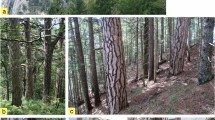Abstract
Previous studies have provided phytosociological descriptions and classifications of the communities of the Taisetsu mountain range, Hokkaido. Here, the authors give an account of the establishment, development and maintenance ofPinus pumila stands and describe the dynamic balance between the pine and its habitat factors, particularly snow depth and wind exposure. The establishment ofP. pumila stands was dependent on the degree of wind exposure and snow depth. The dominancy ofP. pumila diminished gradually on wind-exposed sites but reduced drastically on snow-depositing sites.
Similar content being viewed by others
References
Clements, F. E., 1916. Plant succession: an analysis of the development of vegetation. Carnegie Inst. Washington Publ. No. 242: 3–4.
Gorchakovsky, P. L. & Shiyatov, S. G., 1978. The upper forest limit in the mountains of the boreal zone of USSR. Arct. Alp. Res. 10: 349–363.
Hayata, B., 1911. The vegetation of Mt. Fuji with a complete list of plants found on the mountain and a botanical map showing their distribution. Sanseido, Tokyo. 125 pp.
Hotta, M., 1974. History and geography pf plants. Evolutionary biology in plants. III. Sanseido, Tokyo. 400 pp. (in Japanese).
Ito, K. & Nishikawa, T., 1976. Alpine communities of the northern Taisetsu mountain range(1). Air-and soil-temperature, soil acidity, and a cyclical change of the Vaccinio-Pinetum pumilae. Rep. Taisetsuzan Inst. Sci., Asahikawa Coll. Hokkaido Univ. Education 11: 1–18.
Ito, K. & Nishikawa, T., 1977. Alpine communities of the northern Taisetsu mountain range (2). Syntaxonomy of plant communities. Rep. Taisetsuzan Inst. Sci., Asahikawa Coll. Hokakaido Univ. Education 12: 1–26.
Janssen, J. G. M., 1975. A simple clustering procedure for preliminary classification of very large sets of phytosociological releves. Vegetatio 30: 67–71.
Kil'dyushevski, I. D., 1965. Formation of the vegetation under various environmental conditions in the southern Verkhoyansk range. In: V. N., Sukachev, (ed.), Studies on the Flora and Vegetation of High-Mountain Areas (I., Zuckerman & Rabinowitch, English transl. & eds.). pp. 57–66. Keter Press Binding, Jerusalem.
Kira, T. & Shidei, T., 1967. Primary production and turnover of organic matter in different forest ecosystems of the western Pacific. Jap. J. Ecol. 17: 70–87.
Koaze, T., 1965. The patterned grounds on the Daisetsu volcanic group, central Hokkaido. Geogr. Rev. Japan 38: 179–199 (in Japanese with English summary).
Kobayashi, Ke., 1971. Phytosociological studies on the scrub of dwarf pine (Pinus pumila) in Japan. Journ. Sci. Hiroshima Univ., Ser. B, Botany 14: 1–52.
Kobayashi, Ku., 1956. Asymmetrical ridges in the Japan Alps. Geogr. Rev. Japan 29: 484–492 (in Japanese with English summary).
Koidzumi, H., 1926. Mts. Daisetsu. Daisetsuzan Chosakai, Asahigawa. 364+39 pp. (in Japanese).
Koizumi, T., 1974. Landschaftsökologische Untersuchungen in der alpine Stufe des Kisokomagatake in den japanischen Zentral-Alpen. (mit besonderen Berücksichtigung der Vegetation und des Structurbodens). Jap. J. Ecol. 24: 78–91 (in Japanese with German summary).
Kojima, S., 1979. Biogeoclimatic zones of Hokkaido Islands, Japan. J. Coll. Liberal Arts, Toyama Univ. 12: 97–141.
Konoya, M., Kobayashi, T., Kim, C. W. & Kawachi, S., 1968. Explanatory text of the geological map of Japan, Asahidake. Hokkaido Development Agency, Sapporo. 52 pp. (in Japanese with English summary).
Maarel, E.van der, Janssen, J. G. M. & Louppen, J. M. W., 1978. Tabord, a program for structuring phytosociological tables. Vegetatio 38: 143–156.
Nemoto, M., 1925. Meteorological observations on the Taisetsu-zan, the highest mountain in Hokkaido in the year 1924. Chigaku-Zasshi (J. Geogr.) 37: 205–224 (in Japanese).
Ohba, T., 1974. Vergleichende Studien über die alpine Vegetation Japans. 1. Carici rupestris-Kobresietea bellardii. Phytocoenologia 1: 339–401.
Ohwi, J., 1975. Flora of Japan (new revised and enlarged ed.). Shibundo, Tokyo. 1582 pp. (in Japanese).
Okitsu, S., 1981. Biomass and productivity of Pinus pumila scrub in the Taisetsu mountain range. Rep. Hokkaido Branch Jap. For. Soc. 30: 149–151 (in Japanese).
Sakai, A., 1970. Mechanism of desiccation damage of conifers winterning in soil frozen areas. Ecology 51: 657–664.
Sakai, A., 1976. Adapation of plants to deposited snow. Low Temp. Sci., Ser. B 34: 47–76 (in Japanese).
Sakai, A. & Kurahashi, A., 1975. Freezing resistance of conifers in Japan with special reference to their distributions. Jap. J. Ecol. 25: 192–200 (in Japanese with English summary).
Sakai, A. & Otsuka, K., 1970. Freezing resistance of alpine plants. Ecology 51: 655–671.
Shidei, T., 1956. The effect of some climatic factors on the existence of vertical forest zones in Ou-district. J. Jap. For. Soc. 38: 356–358 (in Japanese).
Takeda, H., Tanabe, K. & Takenaka, Y., 1950. Illustrated manual of alpine plants of Japan. Hokuryukan, Tokyo. 4+50+294+16 pp (in Japanese).
Tatewaki, M., 1963. The vegetation of the Daisetsu volcanic group. In: T. Ishikawa, (ed.), Reports of the Natural Conservation Society of Japan, No. 8. Scientific Researches of the Daisetsu Volcanic Group, pp. 25–59 (in Japanese with English summary).
Tikhomirov, B. A., 1946. On the origin of the dwarf pine (Pinus pumila Rgl.) association. Materials on the history of the flora and vegetation of the USSR, Fasc. II, pp. 469–537. Moscow (in Russian with English summary).
Weaver, J. E. & Clements, F. E., 1938. Plant Ecology, 2nd ed. McGrow-Hill, New York. 601 pp.
Yamada, T., Kikuchi, T. & Kaneda, Y., 1978. Data of air temperature, wind speed and wind direction in the west slope of Mt. Asahidake, central Hokkaido, 1977–1978. Low. Temp. Sci., Ser. A 36–37, Data report: 11–24 (in Japanese).
Author information
Authors and Affiliations
Additional information
Nomenclature follows Ohwi (1975).
The authors wish to express their gratitude to Prof Dr C. H. Gimingham, who kindly read and criticized the manuscript. Acknowledgements are due to Drs H. Fukuda, M. Haruki and S. Higashi, Hokkaido University, for their valuable discussions.
Rights and permissions
About this article
Cite this article
Okitsu, S., Ito, K. Vegetation dynamics of the Siberian dwarf pine (Pinus pumila Regel) in the Taisetsu mountain range, Hokkaido, Japan. Vegetatio 58, 105–113 (1984). https://doi.org/10.1007/BF00044934
Accepted:
Published:
Issue Date:
DOI: https://doi.org/10.1007/BF00044934




